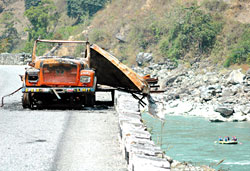|
|
At Fisling, where white water rafters still launch their boats (right), there are charred hulks of tankers destroyed by Maoists to enforce their blockade. Further up the road on Wednesday, army commandos in full battle gear were massed around armoured personnel carriers.
The Royal Nepali Army's elite Ranger Battalion had just come down off the mountain after a major battle on Tuesday in which 21 Maoists were killed. The Maoists in a statement said only 12 of their men were killed.
Further down the road, soldiers of the Sixth Battalion based in Baireni were all smiles when we caught up with them on Wednesday (pictured above). They were headed up the trail on a four hour climb to the battle site where they will be mopping up. The army didn't suffer any casualties in this battle and morale among the soldiers was high.
This was a well-planned attack. Learning from past mistakes, the army bided its time after getting intelligence on Monday that the Maoists were massed up on Chautara hill above the highway. They surprised the camp the next morning with air support. For the Maoists, everything went wrong from the start.
A combined rebel force of 250 guerrillas from Rasuwa, Chitwan and Dhading had mobilised nearly 5,000 villagers to attend a meeting at Lapu village of Gorkha on 19 March to plan an attack on the district capital.
But that plan changed when the rebel leadership called off the blockade the next day after reaffirming an agreement with the seven party alliance. The villagers went home, half the rebels marched towards Kathmandu via Nuwakot while others headed south towards the Chitwan border. The army got wind of one group that had camped at Darechok village and attacked them early Tuesday morning.
|
|
The army seems to be aware of this and is conducting reconnaissance flights and has dispatched more soldiers to the area this week. "This was a big blow to the rebels, losing so many of their fighters," says a local reporter, adding that the Maoists are growing desperate to prove that they are advancing on the capital.
Indeed, the Darechok battle and other ambushes and encounters between the army and rebels around Kathmandu in the past two weeks prove there is heightened Maoist activity near the capital. This means the rebels are following the plan to 'climb on the shoulders and hit the head' under which they may execute high profile attacks on Kathmandu and army bases and police posts along the highway. In a bloody week of carnage, 65 people were killed all over Nepal including 10 policemen in an attack on a police post in Birtamod on Monday and 13 soldiers in Dapcha of Kabhre on Sunday.
But so far the rebels have only succeeded in carrying out ambushes when soldiers move out of barracks to clear obstructions, sabotaged government buildings, and attacked security personnel in the middle of crowded towns increasing civilian casualties. While the rebels had pinned down troops on the Prithbi Highway in the past, this is happening less and less. Army sources told us they are now familiar with the topography along the highway and have stationed posts at strategic locations and improved intelligence.
But however much the army thinks it has superiority, analysts say, in guerrilla warfare in this kind of terrain all it takes is one tree across the road and one ambush to strike a blow. And an attack even bigger and bloodier than the one on Thankot in February that left 12 policemen dead is a near certainty.




